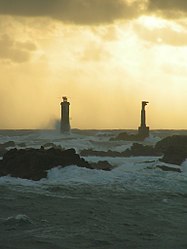Phare de Nividic
| Phare de Nividic | ||
|---|---|---|
| Phare de Nividic | ||
| Place: | Ouessant , France | |
| Location: | Finistère , Brittany , France | |
| Geographical location: | 48 ° 26 '44 " N , 5 ° 9' 3" W | |
| Height of tower base: | 4 m | |
| Fire carrier height : | 35.55 m | |
| Fire height : | 30.4 m | |
|
|
||
| Identifier : | 9 quick white blinks in 10 seconds | |
| Scope knows: | 10 nm (18.5 km ) | |
| Function: | Orientation fire | |
| Operating time: | 1936 | |
Phare de Nividic is the name of a lighthouse on the open sea in front of the Pointe de Perne , on the west coast of the island of Ouessant , in Brittany . At the same time, it also marks the westernmost point of France in Europe. Its name is derived from the rock on which it was built: le Leurvaz an Ividig .
history
Nividic was built between 1912 and 1936 and then only operated for four years. Abandoned during the Second World War , it was restored and renovated several times around 1950. It is still in operation today. Special features include the unique cable car construction for transporting the lighthouse keepers and the later built helicopter landing pad.
The decision to build it was made on January 5th, 1910. The total cost was estimated at around 160,000 gold francs .
24 years of construction
The first work on the masonry began in the summer of 1912, one year after the La Jument lighthouse was put into operation , approx. 3 km south. Due to the numerous reefs and strong currents, it was only possible to add around 50 cubic meters of masonry between the years between 1913 and 1916. However, the First World War did not hinder the work. In 1926, Nividic rose 26 m above the rock. The main building was completed in 1933. Light and fog horn systems were installed between 1929 and 1936. A test run took place in 1933.
In 1936 the electrical signal finally went into operation.
Four years of operation
In 1940, with the arrival of the German Wehrmacht on Ouessant, all coastal lighting had to be extinguished for strategic reasons, thus - after only four years of operation - Nividic too. In 1943 the corroded overhead lines tore . Access to the lighthouse was no longer possible. The decision to finally give up Nividic was made in 1945.
After the war
The lighthouse was not used until 1952. Attempts were then made to resume operation by means of emergency lighting using gas cylinders. However, the difficult access to the tower did not allow trouble-free operation at any time. For this reason, a new power cable was laid in 1953, but this did not bring any significant progress. So were z. For example, no inspection visits are possible from the time of commissioning in February of the same year until August 1955.
In 1958, a 5 x 5 m wooden structure was installed directly above the beacon , which allowed a helicopter to supply the lighthouse with gas bottles in order to be able to use the emergency lighting system again. A test flight on September 26th of the same year confirmed the feasibility of this concept. The newly created access to the tower also enabled renewed renovation, which began in May 1959 and was carried out using 206 helicopter transfer flights.
In 1971 the wooden platform was replaced by a more stable and weatherproof platform made of an aluminum alloy . At this point in time, the power cord was also abandoned and the supply was taken over entirely from the air.
In 1996 solar panels were installed. This measure made it possible to dispense with the 2,000-meter-long, six-tonne supply cable running through two relay towers, which repeatedly led to faults from the start. Its range is ten nautical miles .
A museum on the island provides information about the history of the lighthouses on Ouessant.




